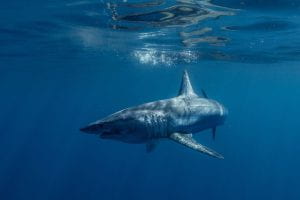
Shortfin makos are the fastest sharks in the sea, but they are failing to outpace the scale of overfishing which is driving them to extinction. Global demand for their meat and lucrative fins has placed this animal on the International Union for Conservation of Nature’s (IUCN) endangered list and on Appendix II of the Convention on Trade in Endangered Species of Wild Fauna and Flora (CITES).
The situation for shortfin mako sharks in the Atlantic Ocean is particularly dire. Populations are currently managed as two assumed separate populations (or stocks), with fishery-based assessments indicating that Northern Atlantic mako sharks are overfished. Independent scientific surveys using data from satellite tags deployed on shortfin mako sharks suggest that fishing mortality may be 10 times higher than estimates from previous fisheries models. With extreme pressure on mako populations from international fisheries, the questions are:
- Has the genetic health and adaptability potential of shortfin makos been compromised?
- Is the current fisheries management strategy based on two populations backed by scientific evidence?
A team of scientists led by Dr. Andrea Bernard and Professor Mahmood Shivji from the Save Our Seas Foundation Shark Research Center (SOSF-SRC) and Guy Harvey Institute at Nova Southeastern University have published their answers in a paper ‘Connections Across Open Water: A Bi-Organelle, Genomics-Scale Assessment of Atlantic-Wide Population Dynamics in a Pelagic, Endangered Apex Predator Shark (Isurus oxyrinchus)’ in the journal Environmental Applications.
Their efforts have been featured in a recent Forbes report.
The scientists have for the first time sequenced entire genomes for mitochondrial DNA and conducted high-resolution scans across the nuclear genomes of shortfin makos from nearly the entire distribution of this species in the Atlantic Ocean. These genomic assessments have discovered a potential lifeline that should add urgency to curbing overfishing.
“Despite decades of fishing pressure, shortfin mako sharks in the Atlantic Ocean still show (relatively) high level of genetic diversity,” said Professor Shivji. “Genetic diversity in a population is what allows species to adapt to environmental change, or to survive catastrophes.”
While overfishing is the single greatest threat to sharks worldwide, many species remain vulnerable to complex and compounding additional threats such as habitat loss, deep-sea mining, pollution, and our changing climate.
“We were rather surprised but also pleased to see that the genetic health of shortfin makos does not appear to have been severely compromised – yet – by the population reductions caused by overfishing,” Shivji said. “Typically, in most of the exploited shark species we study, we see pretty low diversity.”
Such is the case of the critically endangered great hammerhead shark – another species being fished to the edge of existence, but whose vulnerability to being tipped into extinction is higher because they lack the diversity to adapt to our rapidly changing climate.
“What that means is that, if we can prevent further erosion of this genetic diversity in shortfin mako sharks by urgently curbing overfishing, we have more hope for this species to retain the resilience needed for their populations to adapt to our fast-changing climate and survive,” Shivji said.
The scientists also hypothesized that nomadic sharks like makos, which have been tracked making extraordinary journeys across oceans, would mix freely with few genetic barriers. And that is exactly what the research team found from the high-resolution scans made of shortfin mako nuclear DNA.
Nuclear DNA is inherited from both parents, and it suggests that male shortfin mako sharks are indeed ranging across the Atlantic and spreading their genes widely.
“Female mako sharks, which get even larger than males, are quite capable of also making these large-scale journeys,” Shivji said. “But when we look at the mitochondrial DNA – the genetic material inherited only from mothers – we see a contrasting picture.”
The mitochondrial genome sequences show matrilineal genetic structure for Northern and Southern hemisphere populations. That’s scientific-speak for: The populations in each hemisphere are genetically distinct from each other. In fact, the results suggest that while female shortfin mako sharks may well be as wide-ranging as their male counterparts, they are voyaging back to key sites in one hemisphere to birth their pups. And if we’re to protect this important genetic diversity, the management of two distinct Atlantic populations – the Northern and Southern Atlantic shortfin mako sharks – is now backed by this high-resolution genetic information.
###
MEDIA CONTACT
Irvin B. Harrell | Office of Media Relations
Nova Southeastern University
954-262-5355 (office) | 954-945-6471 (cell)